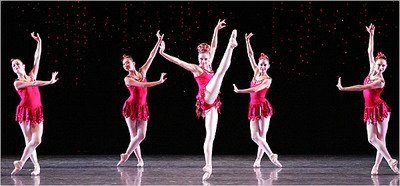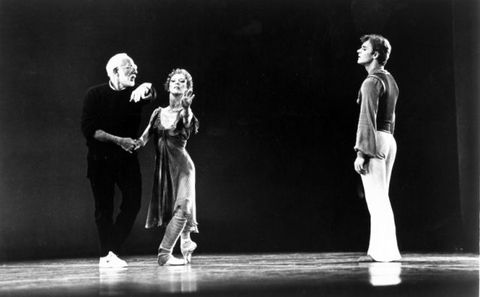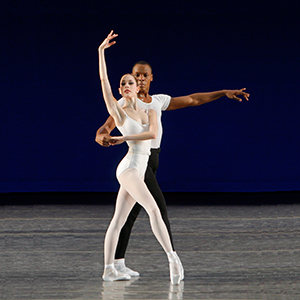foot in mouth: January 2009 Archives
Because I won't have much new to offer in the next few weeks.
u A feature and exclusive interviews with Mikhail Baryshnikov, Wendy Whelan, and Damian Woetzel on Jerome Robbins (April).
u Sidi Larbi Cherkaoui and Akram Khan's "Zero Degrees"--a powerfully helpless melancholy in the face of a senselessly violent world (April).
u War dances and a new inertia (May).
u Julian Barnett's "Sound Memory" and other odes to retro habits (June).
u A cornucopia of New York premieres reviewed: Ratmansky's "Concerto Dsch" at NYCB, Twyla Tharp's "Rabbit and Rogue" at ABT, and onetime bad boy Michael Clark at Lincoln Center's Great Performances (June).
u Neil Greenberg's inward dances (June).
u Alvin Ailey's 50th anniversary, from the inside out (by Theresa Ruth Howard, July).
u Jerome Robbins' controversial "Goldberg Variations," back and front.
u Lovecat: tribute to kitty love (August)
u Thoughts on Forsythe, the controversy around Veronika Part, and ABT's Romantic "Giselle" (August).
u The adored and despised Ann Liv Young, performance artist (October).
u How to watch a Wheeldon ballet (October).
u Antony Tudor, Gillian Murphy, and "Pillar of Fire" (November).
u Being Somebody (on Faye Driscoll's "837 Venice Blvd," December).
As I seem to have fallen into the mode of recommending (I'll fall out as soon as I can), let me recommend to you Edward Villella's lovely, engrossing Miami City Ballet, in Manhattan for the first time after decades in the far reaches of Long Island and New Jersey. (The last time MCB was nearby, the dances' magic competed with canned banter on all sides of me, as if my neighbors had dragged themselves reluctantly from their TVs, stale sit-com jokes clinging to them. In Manhattan and inner outer-borough theaters, there are also contests between the ridiculous and the sublime, though the form they take is different.)

Miami City Ballet's "Rubies" (Photo by Joe Gato for Miami City Ballet)
In keeping with Villella's own illustrious background as a New York City Ballet star and originator of many roles from the late '50s into the '70s, the two programs abound in Balanchine: "Symphony in Three Movements," "La Valse," "Square Dance," "Rubies" from the full-length "Jewels," and "Symphony in C"--every one of them glorious in its own way. (You'd be hardpressed to find a Balanchine that wasn't.)
Villella's dancers have a texture--a granular musicality, soft and thick--that transports you to where the air is distilled, condensed into art.
You know how people who grew up with Balanchine--the over-50 set--like to say, But you should have seen it back in the day? I get tired of hearing this, because I am seeing it now and it is often very much alive to me. But viscosity combined with clarity of steps isn't the way people usually dance now. More often it's either bright and sharp or soft and blurry. And while I believe Balanchine can accomodate many qualities, the ones Villella's dancers favor really work.
The City Center engagement begins tonight and continues through Sunday.
If you aren't in the New York area, your library may have "The Man Who Dances," a 1968 documentary of Villella. He has to be seen to be believed.
So, I made it to the big-screen screening (where, from the fourth row, all the talking heads were enormous) at the Dance on Camera festival last night and can attest to the doc's excellence.
I've read both authorized biographies--the first and more dance-specific by Deborah Jowitt, the second, more biographically oriented, by Amanda Vaill, both wonderful--and certainly understand that Jerome Robbins made his name on Broadway, but to see clips of the shows he directed and choreographed is something else again. Number after number is so whiz bang and brilliant, it's no wonder the likes of Sondheim and Bernstein can't stop calling him a genius.
Plus, there are a few clips of Robbins in his youth dancing: it makes immediate sense why Balanchine would have revived "Prodigal Son" for him and why, as a choreographer, Robbins was drawn to the shades of untamed animal (in "The Afternoon of a Faun") and the Dionysian spirit (in "West Side Story" and "The Dybbuk," for example). As a young man, he's a headlong dancer--rough-edged, full-bodied, fearless.

The documentary is called "Something to Dance About" and is directed by Judy Kinberg, who did all those incredible Balanchine Dance in America programs in the 1970s. Check local listings for the exact evening hour on Wednesday February 18.
For a taste of the archival footage in the film, here is a YouTube clip of "The Afternoon of a Faun" (1953) with New York City Ballet dancers Tanaquil LeClerq, for whom Robbins made the ballet (made all of his ballets, he attests, as an old man), and Jacques d'Amboise.
And if you'd like to see some of his ballets, don't forget you can now do so for all of $25 for State Theater (aka David Koch Theater) orchestra seats!!! if you call Monday first thing. New York City Ballet offers the winter's all-Robbins program Tuesday, Wednesday, and Saturday matinee this week. (I agree, though, with NY Times chief dance critic, Alastair Macaulay, that it may be all Robbins, but it's not best Robbins; I don't agree, however, that Robbins neophytes, much less ballet neophytes, can be introduced to the choreographer or the artform with anything less than the best. If you're not familiar with an artform or artist, you need to start with the indisputable works, not minor ones, so you can take in the whole picture, the full magnitude of the art or artist. An old hand already has a notion of the whole and can makes something of a partial view.) The following week, on the Founding Choreographers 1 program, Robbins's "Dances at a Gathering" appears, which, many people agree, does count as best Robbins. a
About two and a half years ago, we were wondering here on Foot why opera is more likely to generate a buzz than ballet, its dance equivalent. Inevitably we ended up talking about dance recordings and whether they could ever be as good as opera recordings, with some of us feeling they couldn't and others of us feeling they basically could and a third feeling that if they were to succeed, it would have to be not as a simulacrum of the live performance but on their own terms.
Anyway, this is all to say: I should have mentioned the annual Dance on Camera Festival, at the Walter Reade Theater at Lincoln Center, weeks ago, because by now it's almost over!

They have saved some of the best films for last--specifically a preview this Friday at 6:15 p.m. of the long-awaited American Masters documentary on Jerome Robbins, "Something to Dance About," which will air nationwide on PBS on February 18 (check local listings for the hour), and a "Red Shoes"-cum-"Dybbuk" for the Indian classical dance set, "The Chosen One," Friday at 3:30 pm and Saturday at 1 p.m.
In both cases there are special guests--for the Robbins, a panel that includes Judy Kinberg (she did all those incredible Balanchine Dance in America programs in the 1970s), Amanda Vaill (who wrote one of the two definitive Robbins bios), and both former and current Robbins dancers.
Call the Walter Reade Theater at 212-727-0764 or click here for details.
UPDATE: I went to the Robbins screening last night, and it was great, as I note here.
Fifty of them for each performance, starting now and continuing through March 1. I can't tell you how rare orchestra seats at this price are. In fact, outside of the annual Fall for Dance festival, which is heavily subsidized, I've never heard of it. Finally, a really smart marketing
ploy--because it's not just a ploy. Offering dance up close and in the
flesh is an honest way to make converts, because sitting close makes all the difference. If your experience of ballet is from the nose bleed seats, where the dancers can't help but look doll-like, treat yourself.
And which programs do I recommend?
As many as you can get to in the next seven weeks. Otherwise, whichever have the most
Balanchine--and exceptional Robbins. So, Balanchine's evening-length
"Coppelia," Founding Choreographers 1, 20th Century Music Masters, and Founding Choreographers II. Number two choices include Short Stories (so long as it's not your first and only Balanchine), Early Music Masters, Tradition and Innovation, and Four Voices.

Rebecca Krohn and Albert Evans in Balanchine's "Movements for Piano and Orchestra," to Stravinsky's music of the same name. (Photo by Paul Kolnik for New York City Ballet.)
This is the first ballet in which Krohn made her mark--a stark and striking one. She's one of those dancers who lets you feel her choices, yet without ever being portentous about it. A gracefully intelligent dancer. "Movements" shares the Founding Choreographers 1 program with Balanchine's "Monumentum pro Gesualdo" and "Stars and Stripes," and Robbins's "Dances at a Gathering."
The tickets become available the Monday of the week of the performance. You need to buy them after 10 a.m. in person at the David Koch Theater (the onetime New York State Theater, at Lincoln Center) or by phone (call 212-721-6500 and mention code 25ORCH; service charges apply). Click here for details.
AJ Blogs
AJBlogCentral | rssculture
Terry Teachout on the arts in New York City
Andrew Taylor on the business of arts & culture
rock culture approximately
Laura Collins-Hughes on arts, culture and coverage
Richard Kessler on arts education
Douglas McLennan's blog
Dalouge Smith advocates for the Arts
Art from the American Outback
Chloe Veltman on how culture will save the world
For immediate release: the arts are marketable
No genre is the new genre
David Jays on theatre and dance
Paul Levy measures the Angles
Judith H. Dobrzynski on Culture
John Rockwell on the arts
innovations and impediments in not-for-profit arts
Jan Herman - arts, media & culture with 'tude
dance
Apollinaire Scherr talks about dance
Tobi Tobias on dance et al...
jazz
Howard Mandel's freelance Urban Improvisation
Focus on New Orleans. Jazz and Other Sounds
Doug Ramsey on Jazz and other matters...
media
Jeff Weinstein's Cultural Mixology
Martha Bayles on Film...
classical music
Fresh ideas on building arts communities
Greg Sandow performs a book-in-progress
Harvey Sachs on music, and various digressions
Bruce Brubaker on all things Piano
Kyle Gann on music after the fact
Greg Sandow on the future of Classical Music
Norman Lebrecht on Shifting Sound Worlds
Joe Horowitz on music
publishing
Jerome Weeks on Books
Scott McLemee on books, ideas & trash-culture ephemera
theatre
Wendy Rosenfield: covering drama, onstage and off
visual
Public Art, Public Space
Regina Hackett takes her Art To Go
John Perreault's art diary
Lee Rosenbaum's Cultural Commentary

Recent Comments